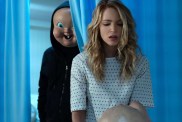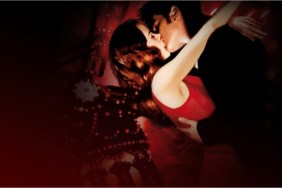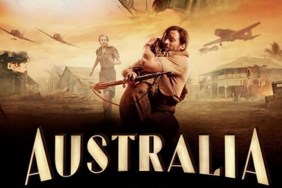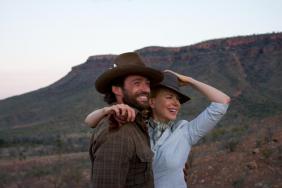Cast:
Nicole Kidman as Lady Sarah Ashley
Hugh Jackman as Drover
Brandon Walters as Nullah
David Wenham as Neil Fletcher
Jack Thompson as Kipling Flynn
Bryan Brown as King Carney
Tony Barry as Sergeant Callahan
Ray Barrett as Bull
Arthur Dignam as Father Benedict
Sandy Gore as Gloria Carney
David Gulpilil as King George
John Jarratt as Sergeant
Jacek Koman as Ivan
Crusoe Kurddal as Aboriginal Tracker
Ben Mendelsohn as Captain Dutton
David Ngoombujarra as Magarri
Angus Pilakui as Goolaj
Bruce Spence as Dr. Barker
Directed by Baz Luhrmann
Summary:
Baz Luhrmann’s long-awaited follow-up to “Moulin Rouge!” may be too long and full of the type of clichéd film ideals we rarely see in movies anymore, but it’s also as glorious and majestic as the continent it champions.
Story:
As WWII breaks out in Europe, Lady Sarah Ashley (Nicole Kidman) leaves her stately British home to run her husband’s cattle ranch Faraway Downs after he disappears. Once there, she bonds with a mysterious Aboriginal half-breed named Nullah (Brandon Walters) and butts heads with a tough but dashing rancher, The Drover (Hugh Jackman), who helps her take on the ranch’s toughest competition, cattle mogul King Carney (Bryan Brown) and his vindictive right hand man Neil Fletcher (David Wenham).
Analysis:
Those who’ve anxiously been waiting seven years for Baz Luhrmann to follow up his magnum opus “Moulin Rouge!” with something as rich and moving and uniquely memorable may see “Australia” as what Peter Jackson’s “King Kong” was to his “Lord of the Rings” trilogy, an epic from a director trying to top himself with a long unrealized passion project. “Australia” is clearly something Luhrmann has wanted to make for years and the results aren’t necessarily bad, but it’s very much a movie that works only for as long as you can appreciate and respect the vision of the filmmaker and what he was trying to achieve. In this case, it’s Luhrmann’s loving tribute to the continent he calls home and its rich history and traditions, as filtered through classic movies of the ’40s.
After an introduction about Australia’s “Stolen Generations”–Aboriginal children separated from their parents to be educated in Western ways by missionaries–we’re introduced to Noolah (Brandon Walters), a young Aboriginal half-breed on the run after seeing a white man being killed before his eyes. That man is the husband of Lady Sarah Ashley (Nicole Kidman), an uptight British socialite who travels to Australia believing her husband has been cheating on her, while there to sell their failing ranch Faraway Downs. She’s greeted there by her rugged guide, a cattle rancher referred to as The Drover (Hugh Jackman), who takes her on the treacherous passage through the continent’s Northern Territory to the ranch. She decides to try to save the ranch but her husband’s ranch hand Noah Fletcher (David Wenham) is fired after an altercation involving Noolah and he leaves to help their main competition King Carney put them out of business.
Broken into a number of distinctively different acts, the film straddles genres from classic Westerns to romantic epic to war movie, but all these genres are used to explore a side of Australia that could only be envisioned by a native. It doesn’t take a film historian to understand what Luhrmann was trying to accomplish, creating a classic film like those from the early days of color film. He doesn’t try too hard to mask the influence of “Gone with the Wind” and “The Wizard of Oz,” the latter being referenced almost to a fault at times. At times, it feels like the filmmaker has far too many disparate ideas to make them work as a single story, especially when he delves into the Aboriginal traditions of walkabout and dreaming, but those are important aspects of the central story involving how the natives of the continent were subjugated by the white man’s desire to “improve” them.
Baz once again works with his favorite leading lady, his 21st Century muse Nicole Kidman, bringing out aspects of her personality we rarely see in movies she’s done since “Moulin Rouge!” Even so, she does sometimes deliberately step back to let Jackman dazzle as a character as rugged as Wolverine but with the charm of his romantic ladies’ man roles. Like with “Moulin Rouge!,” much of the first act is used for them to “meet cute” with light and quirky humor that requires some acclimating, especially when one realizes that the story is essentially following the exact same plot as “Crocodile Dundee,” Jackman even uttering “Crikey!” more than a few times.
Once the group finally delivers their cattle to the docks of Darwin in a race against King Carney’s men to load them onto a cargo ship, things settle down, allowing the inevitable romance between Lady Sarah and the Drover to blossom. Ladies will surely be swooning when they see the cleaned-up Jackman show up at a charity ball wearing a tux. Whether or not Luhrmann really needed three other screenwriters to realize this classic narrative and dialogue is questionable, but there’s little question Jackman and Kidman have a potent chemistry and an undeniable spark when they’re on screen that makes you realize they should make more movies together.
The supporting actors do a fine job fulfilling their respective roles, whether it’s veteran Aussie actor Jack Thompson as the bumbling drunk who acts as comic relief, or Bryan Brown and David Wenham, who both seem to take great pleasure playing the classic moustache twirling film villains of olde. Unfortunately, newcomer Brandon Walters could very well be the Jar Jar Binks of the movie, essentially what will make the difference between whether you like, love or outright loathe Luhrmann’s latest. The entire film is narrated from Noolah’s innocent point-of-view, but his speech patterns can quickly become tiring, and much like everything else in the movie, your enjoyment will rely heavily on your ability to suspend disbelief and accept the fantasy aspects of the movie.
Although the story essentially revolves around the dynamics between the five main characters, there’s enough big set pieces for anyone not necessarily impressed by Luhrmann’s romanticism. These include a giant cattle stampede at the edge of a precipice and the actual invasion of Darwin by the same Japanese airmen who bombed Pearl Harbor–a piece of Australian history that few outside the country will even know about.
Plenty of viewers would have been contented if the movie ended with the premature “happy ending” montage at the two-hour mark, but considering how much the war has been referenced, it’s not a shocker Luhrmann couldn’t end the movie without one big battle scene to separate the characters. Even so, there never really seems to be too much danger or tension as the characters in this third act because following classic film tropes, you’ll always know who’ll live and who’ll die. Few will fault Baz for wanting a happy ending, but one would hope that he would at least try to use the last 45 minutes to shake things up rather than going the most predictable route.
That aside, the overall look and scope of the film tends to make up for the storytelling cliches, and the breathtaking visuals of “Moulin Rouge!” couldn’t possibly prepare you for how big and epic this film is. From the first frame, “Australia” is an unbelievable achievement in cinematography and production design as Luhrmann and cinematographer Mandy Walker capture the Australian landscape in a way that adds to the film’s larger than life look much like Peter Jackson’s impressive use of New Zealand in the “Rings” trilogy. They combine amazing aerial shots with simpler sets and matte painting to maintain the look of a ’40s movie rather than using CG to fake out the viewers. Even so, the production team daringly builds the entire city of Darwin, Australia up from scratch only to raze it during the Japanese attack, which is quite impressive. Composer David Hirschfelder, reuniting with the director for the first time his debut “Strictly Ballroom,” provides the type of sweeping score that perfectly enhances the visuals and the old-time feel that Luhrmann was obviously going for.
The Bottom Line:
“Australia” is a movie for unabashed lovers of old Hollywood war romances, which unfortunately for Baz Luhrmann is a dying breed in this day and age. Maybe it’s not as inherently moving or memorable as “Moulin Rouge!” but the epic scope of the storytelling and filmmaking is enough to suck you in and give you newfound appreciation for what a visionary filmmaker can achieve when given the chance to make films without compromise.










